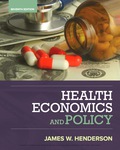3. ACME's pharmaceutical company considers developing a new vaccine whose demand (in thousands) the company estimates will be D(p) = (N+2)(100 - p). The R&D investment needed to develop that vaccine is £5 million. The vaccine would be produced at a constant average cost of £(7N+14). If ACME makes the investment in R&D, it will obtain an exclusive patent from the government and monopolise the market. If it does not invest in R&D, ACME will
3. ACME's pharmaceutical company considers developing a new vaccine whose demand (in thousands) the company estimates will be D(p) = (N+2)(100 - p). The R&D investment needed to develop that vaccine is £5 million. The vaccine would be produced at a constant average cost of £(7N+14). If ACME makes the investment in R&D, it will obtain an exclusive patent from the government and monopolise the market. If it does not invest in R&D, ACME will
Managerial Economics: A Problem Solving Approach
5th Edition
ISBN:9781337106665
Author:Luke M. Froeb, Brian T. McCann, Michael R. Ward, Mike Shor
Publisher:Luke M. Froeb, Brian T. McCann, Michael R. Ward, Mike Shor
Chapter20: The Problem Of Adverse Selection Moral Hazard
Section: Chapter Questions
Problem 3MC
Related questions
Question
N=7

Transcribed Image Text:3. ACME's pharmaceutical company considers developing a new
vaccine whose demand (in thousands) the company estimates will
be D(p) = (N+2)(100 - p). The R&D investment needed to develop
that vaccine is £5 million. The vaccine would be produced at a
constant average cost of £(7N+14). If ACME makes the investment
in R&D, it will obtain an exclusive patent from the government and
monopolise the market. If it does not invest in R&D, ACME will
incur no cost.
a) Determine whether ACME will invest in R&D to develop this
new vaccine. If it does, find the equilibrium price and quantity of
the monopolistic market, the resulting consumer surplus, ACME's
profit and the Lerner index.
b) An NGO has decided to buy the patent from ACME. The NGO
only has £0.6 million to offer ACME for the patent. The NGO plans
to finance the rest of the offer needed to buy the patent from
ACME with the sales of the vaccine. If the NGO's objective is to
maximise the consumer' surplus, what would be the selling price
of the vaccine? By how much would the consumer surplus increase
with respect to (a)? Does social welfare increase as a result? By
how much?
c) Return to the scenario in (a) but assume that ACME estimates
that with 50% probability the government will share the patent
with its most hated competitor, BACME, who then would be able
to produce the vaccine also at a constant average cost of £(7N+14).
The two firms would then compete a la Cournot. Would ACME make
the R&D investment in the first place?
Expert Solution
This question has been solved!
Explore an expertly crafted, step-by-step solution for a thorough understanding of key concepts.
Step by step
Solved in 2 steps

Knowledge Booster
Learn more about
Need a deep-dive on the concept behind this application? Look no further. Learn more about this topic, economics and related others by exploring similar questions and additional content below.Recommended textbooks for you

Managerial Economics: A Problem Solving Approach
Economics
ISBN:
9781337106665
Author:
Luke M. Froeb, Brian T. McCann, Michael R. Ward, Mike Shor
Publisher:
Cengage Learning

Managerial Economics: Applications, Strategies an…
Economics
ISBN:
9781305506381
Author:
James R. McGuigan, R. Charles Moyer, Frederick H.deB. Harris
Publisher:
Cengage Learning


Managerial Economics: A Problem Solving Approach
Economics
ISBN:
9781337106665
Author:
Luke M. Froeb, Brian T. McCann, Michael R. Ward, Mike Shor
Publisher:
Cengage Learning

Managerial Economics: Applications, Strategies an…
Economics
ISBN:
9781305506381
Author:
James R. McGuigan, R. Charles Moyer, Frederick H.deB. Harris
Publisher:
Cengage Learning



